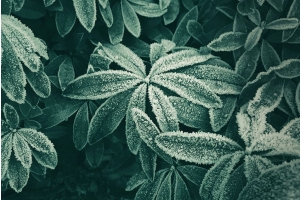Plant Frost Protection Tips for Your Garden

A sudden cold snap can wreak havoc on even the hardiest of plants, so it's essential to have measures in place to ensure they come out of winter unscathed. However, frost protection requires a careful balance – you want to shield your plants without smothering them or accidentally creating conditions that invite rot or fungal disease.
With the right approach, you can keep your garden thriving, even when temperatures plummet. From rearranging your plants to adding protective fleece, here are five practical ways to provide them with the frost protection they need this winter.
Beat the Freeze: A Simple Guide to Plant Frost Protection
Frost can be a gardene's worst enemy, causing irreparable damage to your cherished crops, ornamentals and trees. Let us walk you through how frost impacts growth, the signs of frost damage to watch out for, and easy-to-follow steps to protect your plants from the chill.
Why Frost Protection Matters

Frost damage occurs when water inside plant cells freezes and expands, causing the cell walls to rupture. This process is especially harmful when freezing and thawing happen rapidly, as the plant's tissues struggle to adjust to the drastic temperature changes. Such damage can be fatal to the plant or, at the very least, leave it weakened and vulnerable to disease.
Symptoms of Frost Damage
Frost damage can manifest in different ways depending on the severity, but some common symptoms include:
- Scorching
- Brown or black patches on leaves, fruits and flowers
- Spotting on leaves
- Stem collapse
- Wilting or drooping leaves
- Split bark on trees or woody stems
- Total plant death
Unfortunately, it's often too late to reverse the effects once frost damage is visible. In most cases, the only option is to remove the affected parts to prevent decay spreading. This damage highlights why frost protection is so crucial.
How to Protect Plants from Frost
In most cases, the key to efficient plant frost protection is maintaining a consistent temperature and providing shelter from the elements. You can achieve this with a few practical interventions, as listed below.
1. Invite Your Potted Plants Indoors

The simplest way to protect your outdoor potted or container-grown plants is to take them out of the cold and into a sheltered area with a stable climate. A greenhouse, polytunnel, shed, garage, or even a porch can work wonders for keeping them safe from the frost.
If your planters are too heavy, too big, or there's nowhere suitable to house them, you could insulate them. Wrap the containers in a double bubble wrap or burlap layer and secure them with string or plant ties. Ensure you do not smother the compost surface with insulation, as your plants may rot.

2. Keep Your Greenhouse or Polytunnel Warm

Moving your plants into a greenhouse or polytunnel is a helpful first step, but more is needed to shield them from extreme temperature drops. Focus on maintaining a warm and stable temperature with the following tips:
- Fix Any Gaps: Inspect for cracks, tears, or openings where cold air might creep in and patch them up to prevent heat loss. Use tape from our polytunnel accessories range for an easy and effective fix.
- Invest in a Frost Protection Heater: Electric heaters are the safest choice, as they don't release moisture into the air like propane or paraffin systems. A fan heater will also help circulate air and eliminate cold spots.
- Use Bubble Insulation: Specialist bubble insulation can be clipped to the inside of the frame to reduce heat loss without relying on expensive heating measures.

Move Plants into a Cold Frame or Mini Greenhouse

If you don't have the space to construct a full-sized greenhouse or polytunnel structure, transferring small plants to a cold frame or mini-greenhouse is an effective alternative. Again, when frost bites hard, you can improve insulation by covering the frame with bubble wrap, blankets or layers of newspaper. Don't forget to open the lid on warmer days to prevent overheating and deter fungal diseases.
4. Cover with Frost Protection Fleece

In the same way humans bundle up in the cold months, outdoor plants and trees can also benefit from extra layers of protection – especially if they hail from exotic climates. You can use old fleece, hessian, bracken and straw to insulate your beds and individual pots.
However, investing in specialist frost protection fleece will make life much easier. This breathable material circulates air and moisture, ensuring healthy growth even in cold weather. At LBS Horticulture, we offer convenient fleece jackets that are simple to handle and feature zips for easy securing. Plus, they're reusable, meaning you can count on them season after season for reliable frost protection. Try our XL, XXL and Jumbo jackets to provide excellent shelter to your precious plants, trees and shrubs.
5. Mulch Beds and Borders

Mulching in late November or December is another way to protect your plant's roots from frost. Adding a generous layer of mulch will insulate the roots and seal some crucial warmth and moisture into the soil. Refrain from using plastic sheets or heavy tarps, which can block moisture and air circulation. Instead, opt for organic materials like compost, bark, or wood chippings to provide a natural barrier while allowing the soil to breathe.

Guarantee Effective Frost Protection for Your Plants at LBS Horticulture
By putting these ideas into practice, your plants will survive and thrive throughout the colder months. All that's left to do is stock up on our helpful covers, growing media and accessories to assist with your plant care.
If you have any enquiries or need extra information about our products, simply contact us, and our team will be happy to help. Alternatively, browse our additional blog posts to get your hands on more helpful guides and horticultural advice.












